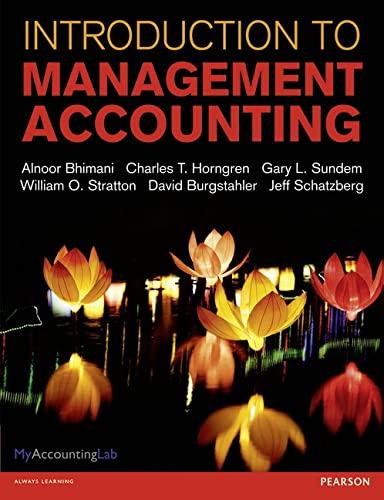The president of North Shore Railroad wants to obtain an overview of the companys operations, particularly with
Question:
The president of North Shore Railroad wants to obtain an overview of the company’s operations, particularly with respect to comparing freight and passenger business. He has heard about ‘contribution’ approaches to cost allocations that emphasise cost behaviour patterns and contribution margins, contributions controllable by segment managers and contributions by segments. The president has hired you as a consultant to help him. He has given you the following information.
Total revenue in 20X3 was €80 million, of which €72 million was freight traffic and €8 million was passenger traffic. Fifty per cent of the passenger revenue was generated by division 1, 40 per cent by division 2 and 10 per cent by division 3.
Total variable costs were €40 million, of which €36 million was caused by freight traffic.
Of the €4 million allocable to passenger traffic, €2.1, €1.6 and €.3 million could be allocated to divisions 1, 2 and 3, respectively.
Total separable discretionary fixed costs were €8 million, of which €7.6 million applied to freight traffic. For the remaining €400,000 applicable to passenger traffic, €80,000 could not be allocated to specific divisions, while €200,000, €100,000 and €20,000, were allocatable to divisions 1, 2 and 3, respectively.
Total separable committed costs, which were not regarded as being controllable by segment managers, were €25 million, of which 80 per cent was allocable to freight traffic. Of the 20 per cent traceable to passenger traffic, divisions 1, 2 and 3 should be allocated €3 million, €700,000, and €300,000, respectively; the balance was unallocable to a specific division.
The common fixed costs not clearly allocable to any part of the company amounted to €800,000.
1. The president asks you to prepare statements, dividing the data for the company as a whole between the freight and passenger traffic and then subdividing the passenger traffic into three divisions.
2. Some competing railroads actively promote a series of one-day sightseeing tours on summer weekends. Most often, these tours are timed so that the cars with the tourists are hitched on with regularly scheduled passenger trains. What costs are relevant for making decisions to run such tours? Other railroads, facing the same general cost structure, refuse to conduct such sightseeing tours. Why?
3. Suppose that the railroad has petitioned government authorities for permission to drop division 1. What would be the effect on overall company net income for 20X4, assuming that the figures are accurate and that 20X4 operations are expected to be in all respects a duplication of 20X3 operations?
Step by Step Answer:

Introduction To Management Accounting
ISBN: 9780273737551
1st Edition
Authors: Alnoor Bhimani, Charles T. Horngren, Gary L. Sundem, William O. Stratton, Jeff Schatzberg





